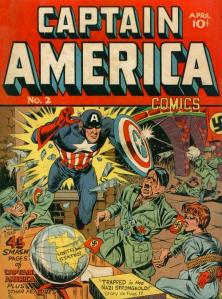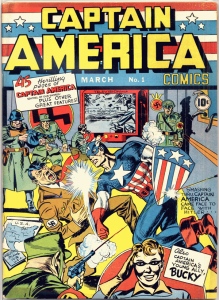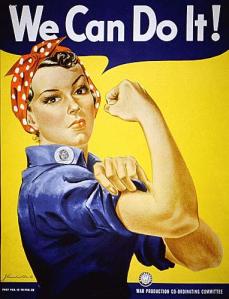“Captain America is among the truest of superheroes. He was born out of something very real and immediate. We were on the cusp of entering World War II and he stood as an answer to the fears of many American children.” –John Cassaday
All superheroes have been criticized for being one-dimensional, but Captain America gets the worst rap. His single-minded obsession with justice seems like an obvious choice for a guy prancing around draped in an American flag. In his most recent incarnations, Steve Rogers has felt more well-rounded: When he is asked in the film Captain America: The First Avenger if he wants to kill Nazis, he says, “I don’t want to kill anyone. I don’t like bullies. I don’t care where they’re from.”
(This is, for the record, my favorite superhero quote. I have it, along with Cap’s shield, tattooed on my shoulder.)
But Captain America began as nationalistic propaganda. Obviously he started out as a specifically anti-Nazi character. In more recent years, he’s been pro-American in different ways. The most blatant use of Cap as propaganda within the past fifteen years came just after 9/11.
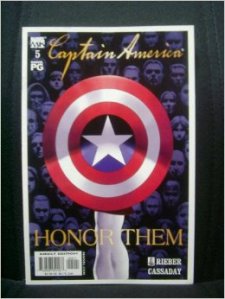
{Image is a scan of a comic book cover. Captain America’s shield takes up most of the page. Faces of various men and women are in the background. Gold script at the top of the page reads, “Captain America.” Gold print at the bottom of the page reads, “Honor Them.”
Today’s lesson plan is a four-day unit about Captain America and propaganda in the 1940s and early 2000s. The unit’s plan assumes that your classroom runs on block scheduling with 90-minute classes. If you have shorter class periods, you can definitely amend the unit to match your time constraints.
Captain America: The First Avenger (film), dir. Joe Johnston, screenplay by Christopher Markus and Stephen McFeely
Captain America: Honor Them (#5), John Ney Rieber (writer) and John Cassaday (artist)
Students will engage in lecture, whole group instruction, discussion, and a project.
Materials Needed:
- Copies of Captain America: Honor Them
- DVD copy of Captain America: The First Avenger
- DVD player and projector
- Poster board
- Computers for research
- Markers, glue, and other art supplies
Standards Met:
- “CCSS.ELA-LITERACY.CCRA.R.6 Assess how point of view or purpose shapes the content and style of a text.”
- “CCSS.ELA-LITERACY.RH.9-10.6 Compare the point of view of two or more authors for how they treat the same or similar topics, including which details they include and emphasize in their respective accounts.”
DAY ONE
- Have the students define propaganda. This should take less than five minutes.
- Show the students propaganda from World War II. Compare this to Captain America propaganda of the same time period. Have the students point out similarities and differences. This should take ten to fifteen minutes.
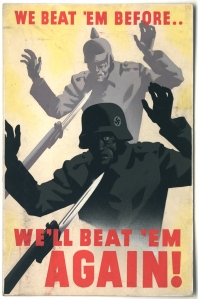
{Image is a World War II propaganda poster. A Nazi soldier is in the foreground with a bayonet pointed at his neck. He is holding his hands up in surrender. A German WWI soldier is in the background, mirroring this position. The text reads, “We beat ’em before..we’ll beat ’em again!”
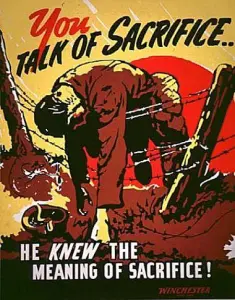
{Image is a World War II propaganda poster. A dead soldier lies across a barbed wire fence. The text reads, “You talk of sacrifice…he knew the meaning of sacrifice!”}
- Begin watching Captain America: The First Avenger. Have the students keep an eye out for any propaganda in the film. For example, how does Steve Rogers react to propaganda? How is he used as propaganda?
DAY TWO
- Continue watching Captain America: The First Avenger. (The film is 124 minutes long.)
DAY THREE
- Have the students recap Captain America: The First Avenger. What propaganda did they notice? How was that propaganda similar to what they saw of the original comics/the other 1940s propaganda? What did the students think of the film overall? This discussion should take 5-10 minutes.
- Remind the students of the events surrounding 9/11. Discuss America’s mood directly after 9/11. What do the students already know? What gaps need to be filled? This discussion should take 5-10 minutes.
- Show the students this image of Cap from the Ultimate Comics directly after 9/11, when some Americans were angry with the French for not supporting the War on Terror:
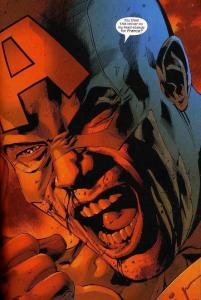
{Image is a scan of a comic. It is a close-up of Captain America’s face. He is pointing at the A on his cowl and yelling, “You think this letter on my head stands for France?”}
- Divide the students into groups and give each group a copy of the comic to read. I advise this just because single issues of comics, especially older comics, can be so expensive. Captain America: Honor Them is available on Amazon for $2.97.
- Pass out poster boards to each student. Have the students design posters explaining Captain America’s role as propaganda. They can refer to the notes they took on The First Avenger as well as any notes they took on Honor Them. How is Steve affected by propaganda? How is he used as propaganda? How does the effectiveness of this propaganda change over time—is it effective now? Would it have been effective when it was first published? This project may be completed outside of class.
DAY FOUR
- Hang up the posters around the classroom. Give the students about ten minutes (can be more or less depending on how the class is acting) to study their classmates’ posters.
- Have the students discuss elements of each other’s posters. What seems to be the overall consensus about Captain America and propaganda? What do the students like about Captain America? Do they prefer him as propaganda? What do they think makes comics fun?
As usual, if you use this lesson plan or any of the other lesson plans from this blog, tell me about it in the comments!

